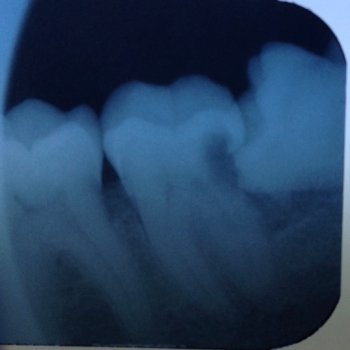Wisdom Tooth
Coming In Pain
Wisdom tooth coming in pain can be caused by a couple of things. I will list the most common causes of wisdom teeth pain first!
Probably the most common wisdom tooth problem I see is where a wisdom tooth (dentists call them Third Molars) has started to come through the gum line on the lower jaw. The wisdom teeth are the last teeth to come into the mouth, usually between 18 to 22 years of age.
The gum is red and sore around the new tooth, and even a little swollen. Sometimes you cannot open your mouth very wide. You feel like your jaw is stiff, and you just can't open your mouth like normal.
There are 2 problems causing this wisdom tooth coming in pain.
1. First problem, the tooth is irritating the gum as it grows.
"Teething"!
As long as the tooth has enough room to grow, and is pointing straight up, it will eventually come through the gum properly, like any other tooth.
But while it's growing, the gum tissue can be quite sore. The best way of helping at this time is rinsing around the gum with warm salt water, and taking some over-the counter pain relievers such as ibuprofen ("Advil"), with paracetamol (Tylenol). A small drop of clove oil on a small cotton ball placed at the back of the mouth can also help. The oil is much better than trying to use a whole clove.
 swollen gum over a wisdom tooth as it comes through
swollen gum over a wisdom tooth as it comes throughWisdom Tooth
Coming In Pain
For the hot saltwater rinse, just pour out about half a cup of hot water, and add half a teaspoon of normal table salt. Stir it up and wait for it to cool a tad - you don't want to burn your mouth!
Next, take a small mouthful of the hot salt water rinse to check the temperature. If it's OK (it should be quite hot), then swish it around the painful wisdom tooth at the back of your mouth for 20 seconds. You should try to swish it around quite forcefully. Then, spit out. Do it again a second time over the affected area. And then finally do it again a third time.
So now the gum over the wisdom tooth has had a full 60 seconds of hot salt water over it. What does this do? It does 2 things!
First, the salt will inhibit the bacteria around the wisdom tooth. This effect lasts an hour or so, enough time to kill the bacteria and give the gum a much-needed break from the irritation and inflammation.
Second, the heat opens up all the tiny blood capillaries in the area, allowing your own immune system a better shot at coping with the inflammation.
For this to be really effective, though, you need to do it 3 times a day, morning, afternoon and evening. It's not the most pleasant thing to do, but it's better than wisdom tooth pain!
At other times through the day, you might want to try another home remedy; Get a cucumber and cut off several slices about 2mm thick. Then put them in the refrigerator. After a few hours, they should be quite cold. Then you can take out a slice, cut it in half, and put the half slice over the sore wisdom tooth. It works like a miniature ice pack.
The coldness of the cucumber is very soothing on the gum, and the cucumber itself has anti-inflammatory properties! The first half slice will take some of the heat out of the gum, and after a minute you should take it out and replace it with the other half. That way the effects last longer. The second half of the slice can be left in place for around 5 minutes before it warms up.
If you want you can repeat this cucumber application another 1 or 2 times with fresh slices from the refrigerator. You can also do this with damp tea bags - just make sure they do not become frozen!
Wisdom Tooth
Coming In Pain
2. The second problem arises if there is a lack of space, and the tooth does NOT have enough room to grow through, and gets jammed against the next tooth. Any wisdom tooth that cannot come through straight is called an impacted tooth.
Now it is stuck halfway in and halfway out, with not enough space. The gum is sore and swollen. And plaque starts to collect around the tooth, because it's difficult to get a brush back there. So now there is a gum infection, too! This is when it can get difficult to open your mouth wide, and you may notice bad breath.
 impacted wisdom tooth
impacted wisdom toothIn the image above,
the wisdom tooth on the right is lying on its side, jammed up against the next tooth, and it has caused a cavity in the side of the neighboring tooth.
Wisdom Tooth
Coming In Pain
At this stage, hot salt water will help, but you probably need some antibiotics as well to help settle things down. After that, you might need to see about getting the tooth removed.
If the tooth is lying on its side, under the gum, it will probably never come through the gum. But it can grow against the next tooth. This pressure can cause a dull ache which may become a quite severe pain.
The wisdom tooth will not be able to move, and the roots will continue to form. This continuous pressure may cause part of the next tooth to erode, leading to tooth decay and a cavity. Unfortunately, this can lead to both teeth having to be removed.
The next most common cause of wisdom tooth coming in pain I see is an UPPER wisdom tooth that has grown through as normal, but then starts hitting on something.
Sometimes it comes through at an angle, pointing out towards the cheek. Of course, in this position, the tooth irritates the inside of your cheek. It can even cause a semi-permanent ulcer.
If it is pointing in the right direction, (straight down), and the lower wisdom tooth is not there, then the top one can start to hit the lower gum when you chew. Ouch! Below is an X-ray showing this problem.
 The wisdom tooth at the top right of this picture has nothing to bite on but gum. The lower wisdom tooth is impacted under the gum. Image courtesy Dr. Howard Farran DDS
The wisdom tooth at the top right of this picture has nothing to bite on but gum. The lower wisdom tooth is impacted under the gum. Image courtesy Dr. Howard Farran DDSQuite often, the upper tooth is hitting on the gum of the lower jaw, and the lower wisdom tooth is half-way through, but jammed on the next one along. Double trouble!
The solution?In this situation, the lower jaw is painful, but the quickest and best option is to take out the TOP tooth. This stops the biting on the lower gum, and makes things more comfortable very quickly. In due course, the lower tooth will have to be removed too.
More rarely, an impacted wisdom tooth can get a cavity. In this case, you get a normal toothache. Again, the solution is usually to have the tooth removed!
Summary of Wisdom Tooth
Coming In Pain
Wisdom tooth coming in pain can have one of several causes. As long as the tooth has enough room to come through, it will usually settle down on its own.
Frequently, however, the tooth does NOT have enough room to come through, and it will need to be removed, usually by an oral surgeon. Wisdom teeth removal is mostly done with local anesthetic.
WISDOM TOOTH PAIN
Wisdom tooth removal complications can include bleeding from the socket, damage to the nerve in the lower jaw resulting in a numb lip or tongue, and a dry socket.
Usually, excessive bleeding after wisdom teeth removal can be prevented by the dental professional placing 1 or 2 sutures (stitches) in the gum, to help it heal over; and by holding a cotton gauze pad over the socket for 30 to 45 minutes after the extraction. If you DO get prolonged bleeding, a useful home remedy is to put a damp tea bag over the socket and bite gently. The tannic acid in the tea helps to stop the bleeding.
After the local anesthetic wears off, any pain can be controlled by taking normal pain relievers from the drug store. Remember to try to keep food particles out of the socket.
You can read more about this at my page on what foods to eat after wisdom tooth extraction.
If you DO get a dry socket, you need to go back to the dentist to get it treated. You can read more about this at my page on dry sockets.



